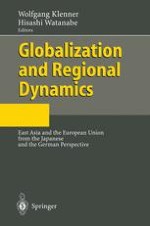2002 | OriginalPaper | Buchkapitel
Effects of Globalization and Crisis upon Competitive and Cooperative Relationships in Asia: The Example of the Japanese and East Asian Electronics Industries
verfasst von : Sachio Imakubo
Erschienen in: Globalization and Regional Dynamics
Verlag: Springer Berlin Heidelberg
Enthalten in: Professional Book Archive
Aktivieren Sie unsere intelligente Suche, um passende Fachinhalte oder Patente zu finden.
Wählen Sie Textabschnitte aus um mit Künstlicher Intelligenz passenden Patente zu finden. powered by
Markieren Sie Textabschnitte, um KI-gestützt weitere passende Inhalte zu finden. powered by
It is my task to report on the “Effects of Globalization and Crisis upon Competitive and Cooperative Relationships in Asia” from the Japanese perspective. Since I find this topic far too broad, I should like to limit myself to one example, the electronics industries in Japan and in East Asia. By East Asia I mean not only Northeast but also Southeast Asia. The electronics industry, one of the main driving forces behind the “East Asian Miracle,” is playing the leading role in the revival of productivity after the recovery from the Asian Crisis. In other words, it is functioning as one of the most important factors in the recovery from the crisis and the stabilization of the economy. Within the framework of the globalization of this industry up to the 1990s, an international system for the division of labour in East Asia arose, which had its centre in Japan, and which is closely involved with the competitive and cooperative relationships of the electronics industry in this region. The Asian Crisis and the long–lasting weakness in the business cycle of the Japanese economy are also having severe effects as destabilizing elements within this system of division of labour upon the structure hitherto found in the electronics industries of Japan and East Asia. Thus viewed, the electronics industry offers some helpful illustrations for our topic.
